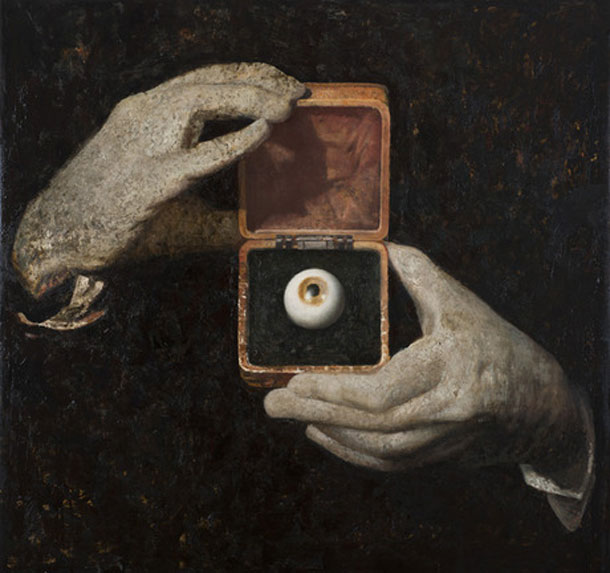
Vincent Desiderio, Hitchcock’s Hands, 2012 oil and mixed media on canvas 64 x 66 inches
(Courtesy of the artist and the Marlborough Gallery)
Vincent Desiderio is widely considered to be among America’s most preeminent living painters. He is currently having his eighth one-man exhibition of new work at the Marlborough Gallery 40 West 57th Street, NYC this show is up until February 8, 2014.
Vincent Desiderio is also the 2014 JSS in Civita Master Class Guest-of–Honor. He will be in residence July 14th to August 4th. More information can be found here.
Desiderio is a senior critic at the Pennsylvania Academy of the Fine Arts and the New York Academy of Art. He lives and and works in Sleepy Hollow, NY. Desiderio received a BA in fine art and art history from Haverford College in 1977. He subsequently studied for one year at the Accademia di Belle Arti in Florence, Italy, and for four years at the Pennsylvania Academy of the Fine Arts between 1979 and 1983.
He is a recipient of a Pollock-Krasner Foundation Grant, two National Endowment for the Arts Grants, the Everson Museum of Art Purchase Prize, a Rome Grant from the Creative Artists Network and a Cresson Traveling Scholarship from the Pennsylvania Academy of the Fine Arts. In 1996, he became the first American artist to receive the International Contemporary Art Prize awarded by the Prince Ranier Foundation of the Principality of Monaco.
His works are included in the collections of the Metropolitan Museum of Art, the Hirshhorn Museum and Sculpture Garden in Washington, DC, the Denver Art Museum, the Everson Museum of Art in Syracuse, New York, Pennsylvania Academy of the Fine Arts, Galerie Sammlung Ludwig in Aachen, Germany, the Greenville County Museum of Art in South Carolina and the Indiana University Museum of Art in Bloomington, Indiana.
According the Marlborough Gallery’s website, Desiderio’s current show of paintings are based on a common theme that the artist calls “reification” – defined by the Free Dictionary as: “the conversion of an abstract concept into something concrete; a viewing of the abstract as concrete.”
Donald Kuspit remarked in his 2011 artnet.com essay Pitiless Pathology: Vincent Desiderio’s Paintings
…There is a profound ambivalence at the core of Desiderio’s pictures, suggesting that he does not so much unite the classical and modernist opposites as tie them in a Gordian knot, making his paintings uncannily eloquent.
Painting Perceptions greatly thanks Vincent Desiderio for taking the time away from his busy painting schedule for this email interview.
Larry Groff: In your 2005 interview with Donald Kuspit you talked about your start as an abstract expressionist painter. Since then you’ve become one of the world’s most respected figurative painters. I’ve read that your studies sometimes involve drawing and painting abstractly and that you attach great importance to abstraction in the structure of your completed paintings. What thoughts or advice would you give someone seeking rigorous figurative training but also wants to be a 21st century painter painting modern concerns.
Vincent Desiderio: I really cannot speak to the idea of figurative painting as something apart from abstract painting or conceptual painting. It would be nice if I could but I don’t really think in terms that make a significant distinction between these approaches. I wince when I am referred to as a figurative painter. I am a painter.
As a result, I have difficulty identifying what exactly constitute the fundamentals of drawing and painting. I know that a so called classical education can be beneficial when one wishes to acquire certain types of skill and that programs that offer this type of training are enjoying a renewed popularity among young artists. However I am wary of the rote academic (in the pejorative sense) nature of such an approach. More often than not this pedagogical method tends to imprison student forcing them to force their imaginations into forms that may be inappropriate.
When we make a painting we are building a psychologically charged sensual space of possibilities. We can build it as a prison of as an observatory. I prefer the latter.
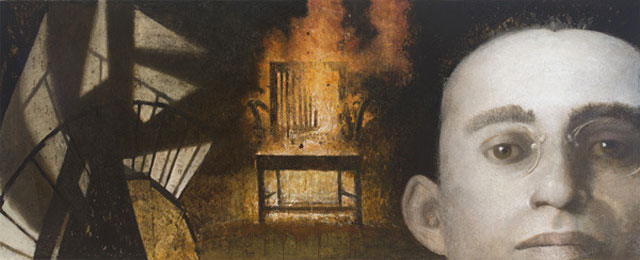
Vincent Desiderio, Exodus, 2013 oil and mixed media on canvas mounted on board 59 x 145 inches
(Courtesy of the artist and the Marlborough Gallery)
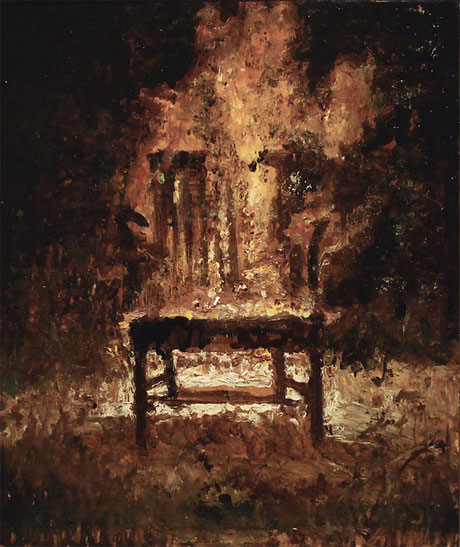
Vincent Desiderio, Study for Exodus: Burning Chair, 2013 oil on paper 16 x 13 1/2 inches
(Courtesy of the artist and the Marlborough Gallery)
LG: Some complain that universities and art schools don’t focus enough on the fundamentals of drawing and painting anymore, that student graduate without strong figurative skill. Others feel that the emphasis on art theory, art history and critical thinking is more desirable. What do you think is a healthy balance between theory and practice in the education of figurative painters? Is there too much talk or not enough?
VD: The encounter with theoretical readings by students who have not learned to think critically about them generally leads to the creation of “theoreticisms” or illustrations of ideas already expressed verbally. This is usually accompanied by a stunning ignorance of the history of art. For me painting itself is a theoretical vanguard.
Painting is painting. It is all an artifice—a lie through which the truth is revealed, as Picasso famously said.
It is always and everywhere representational, conceptual, ironic and abstract. That these components have, over the last century, precipitated out of the vast soup that constitutes the historical practice of painting finding expression in a variety of new media, does not mean that they have not always been at play within painting.
Students should be aware of the histories of these components and how they came to be identified with intellectual developments in other disciplines.
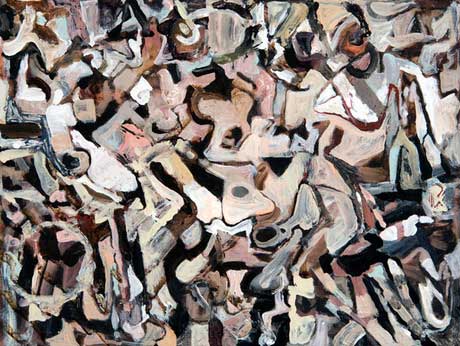
Vincent Desiderio, Abstract Study After Michelangelo, Study for Sleep I,
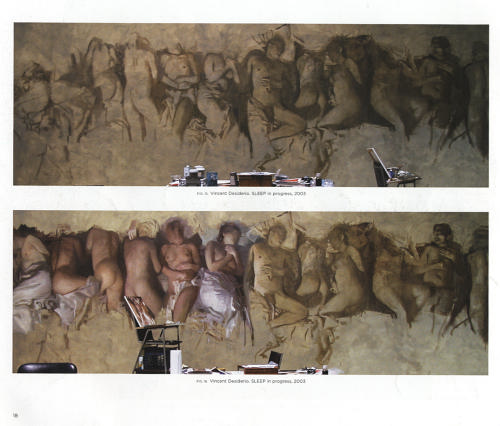

Vincent Desiderio, Sleep, 2008 oil on canvas 52 x 252 inches
Note: click on image for larger view
(ed. note: great read on this painting, excellent essay Unfinished: On Vincent Desiderio’s ‘Sleep’ by Lawrence Weschler in the Nov. 9, 2005 Virginia Quarterly.)
LG: I understand that you paint in an indirect manner, starting with many drawings and oil studies before making an underpainting. Which you then build up the painting with glazing and scumbling. I’m impressed with how open the painting remains throughout this process, right up until the end you are able to make major changes to the painting. I would think that direct painting is better suited for keeping the painting open like this, why do you prefer this manner of working?
Also, please tell us something of the technical side of your painting process and how this technique influences the painting’s evolution. How important are your oil sketches to your larger work?
VD: In regard to my technical practices, I am all over the map. 90% of painting is direct. Indirect methods appear and can be utilized at any time in the course of a paintings development.
Look at the pentimenti that we find in Raphael, Titian and Caravaggio. They didn’t paint like the so-called northern primitives. They repainted but still maintained the ultimate balance.
My sketches familiarize me with the problems I will encounter in the final work. They are experiments in the technical narrative, which I feel is the preeminent narrative in painting.
I don’t know why students don’t prepare themselves more before they begin a larger picture. Charcoal drawings won’t suffice. The management of the surface must be considered as well as the evolution of the paint.
My pictures, more often than not, begin with considerations of the technical narrative. I sense a quality of paint and the possibilities for its evolution and generally out of this the dramatic narrative emerges.
All painting is an intellectual activity. As Motherwell said, it is an intellectual decision to paint emotionally. I would add that it is an emotional decision to paint intellectually.
When painting manages to access the “real” in our existence, when it evokes a perpetual sense of being and does not allow itself to be relegated to the category of artifact, when it pushes its aspirations to the brink of total collapse but remains intact – then it will find its subject. And its subject will be important as equipment for ours and all times.
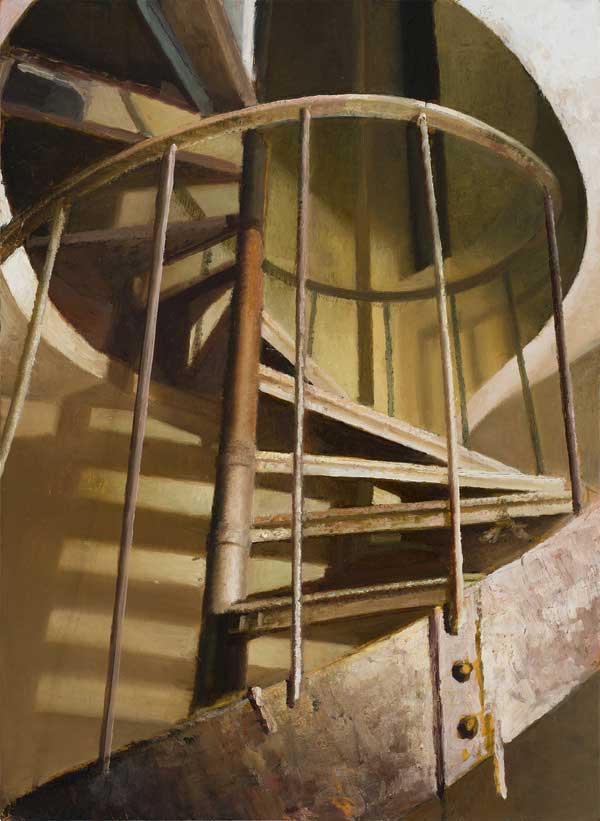
Vincent Desiderio, Study for Circular Staircase, 2012 oil on board 19 x 13 3/4 inches
(Courtesy of the artist and the Marlborough Gallery)
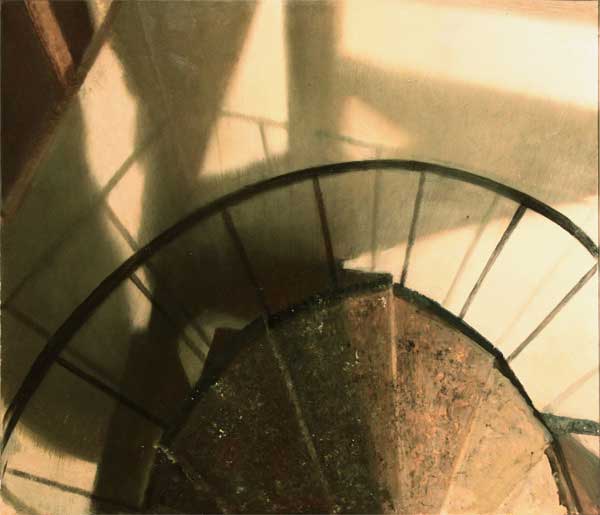
Vincent Desiderio, Study for Exodus: Stairs, 2013 oil on paper 16 x 18 1/4 inches
(Courtesy of the artist and the Marlborough Gallery)
LG: I understand that in your master class workshops you have exercises where the students observe a model for a short period of time and then paint the model without the model present. This sounds like a great way to help students learn to paint the model from memory.
VD: All of my paintings are inventions. I rarely work with live models so I have been forced to learn to paint from my imagination. I construct the pictures in spite of they way things might actually look. But I am always looking at things and asking myself if I need the information at the moment or not.
The incidences of pure memesis, purely perceptual works are few in the history of western art.
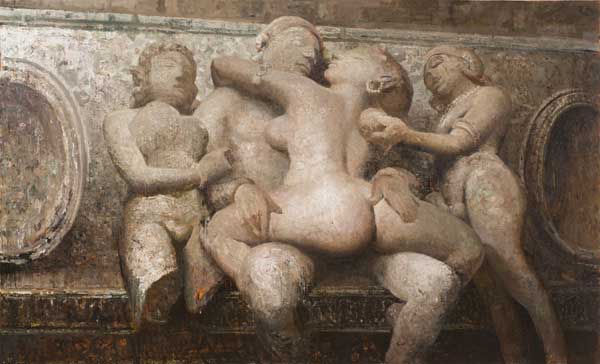
Vincent Desiderio, Transubstantiation, 2013 oil and mixed media on canvas mounted on board 68 x 111 inches
(Courtesy of the artist and the Marlborough Gallery)
LG: I’ve read that Delacroix’s paintings and writings about light and other matters have been very influential to you. If I understand this correctly, you try to keep much of the painting in a certain range of relatively close values, like the light seen on a grey day and then orchestrate the contrasts of light and dark almost as if the clouds parted and a blast of full sun fell on the desired area of focus. Can you tell us more about how you invent and use light in your painting?
VD: Delacroix is a great hero of mine, especially as he allegorizes technique.
Among the romantics, who frequently sought insight and inspiration in exotic places, terrifying emotional states, and the sublime exaltation of nature, Delacroix located this experiential narrative within the act of painting itself—specifically, within the optics of illuminations zone of greatest chromatic activity: half-light. Through its emphasis, Delacroix would enact one of the greatest disturbances in the continuity of forms privilege within the rational structure of painting.
In Delacroix’s paintings light filters onto scenes in a mottled fashion, punctuating a visual field already established in half-light. On May 5th 1852, he made a curious journal entry (below) describing colors relationships in terms of the optics of illumination, which anticipated the eventual subversion of form by color in avant-garde painting. Its substance is absolutely central to the artist’s conception of color – both optically and as an allegorization of the exotic.
a picture should be laid-in as if one were looking at the subject on a grey day, with no sunlight or clear-cut shadows. Fundamentally, lights and shadows do not exist. Every object presents a color mass having different reflections on all sides. Suppose a ray of sunshine should suddenly light up the objects in this open-air scene under grey light, you will then have what are called lights and shadows, but they will be pure accidents. This, strange as it may appear, is a profound truth and contains the whole meaning of color in painting.
For Delacroix half-light of a gray day represented an exotic realm where color was free to demonstrate its highly reflective propensity, undisturbed by incidents of direct light and shadow:
In describing shadows as mirrors, Delacroix inferred that the reflective potential of objects untouched by direct light is obliterated by direct illumination. Remarkably, Delacroix’s not only accords half-light privilege over the classical light mass, but endows it with both optical truth and symbolic meaning, later fully played out in the divergent interests of the impressionists and postimpressionists.
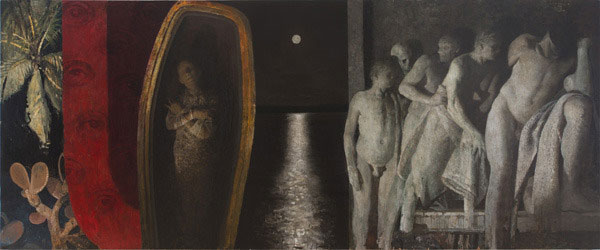
The Awful Indifference, 2013 oil and mixed media on canvas mounted on board 60 x 144 inches
(Courtesy of the artist and the Marlborough Gallery)
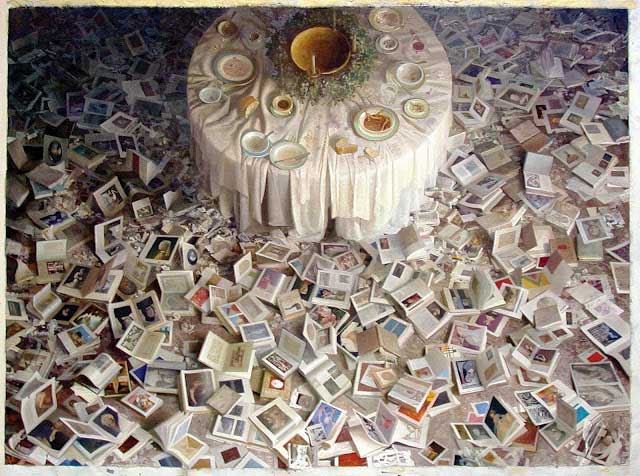
Vincent Desiderio, Cockaigne, Cockanigne, 1993-2003 Oil on canvas 112 1/8 x 153 3/8 Hirshorn Museum and Sculpture Garden
(Courtesy of the artist and the Hirshorn Museum)
LG: Have you ever copied masterworks in museums and do you see that as an important activity for students?
VD: I’ve actually never painted in a museum. I’m too timid. But you might know a painting I did a few years ago called “Cockaigne” in which I painted about 300 reproductions in books strewn all over a floor.
It is really a good idea to copy paintings. It’s strange to me that students will use models and photographs as source material but they shy away from studying how a master would have handled a certain passage.
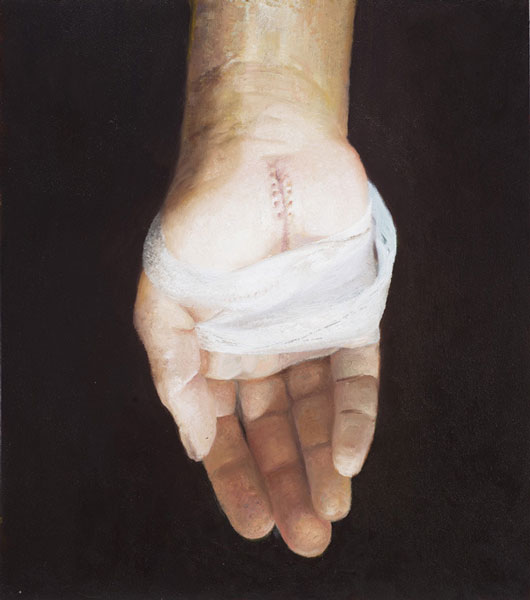
Vincent Desiderio, Study for Hand,2012 oil on board 23 1/4 x 20 3/4 inches
(Courtesy of the artist and the Marlborough Gallery)
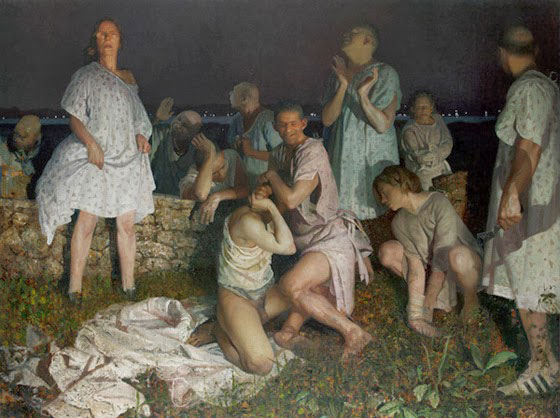
Vincent Desiderio, I’Liberati, 2011 oil and mixed media on canvas 66 x 88 1/2 inches
(Courtesy of the artist and the Marlborough Gallery
LG: Is there a relation of your paintings to film? Some of your paintings seem evocative of the staging of a movie set. Your 2011 painting, I’Liberati, has art historical references but also prompts me to wonder if it might have also been inspired by the 1966 French film, “King of Hearts“, where escaped mental patients during World War I take over a town? I heard that at some point you considered making a film that somehow involved your 2008 painting “Sleep”.
I was not thinking of the “King of Hearts,” though I know the film. Cinema is as big an influence on my work as is the history of painting.
If however the influences are apparent it is through sublimation rather than imitation. For me film is closer to painting than anything else. I have experimented with film and video and just recently worked as the production designer for a Canadian film project…a crash course on film making if ever there was one.

Vincent Desiderio, Study for Exodus: Gramsci, 2013 oil on paper 16 x 18 1/8 inches
(Courtesy of the artist and the Marlborough Gallery)
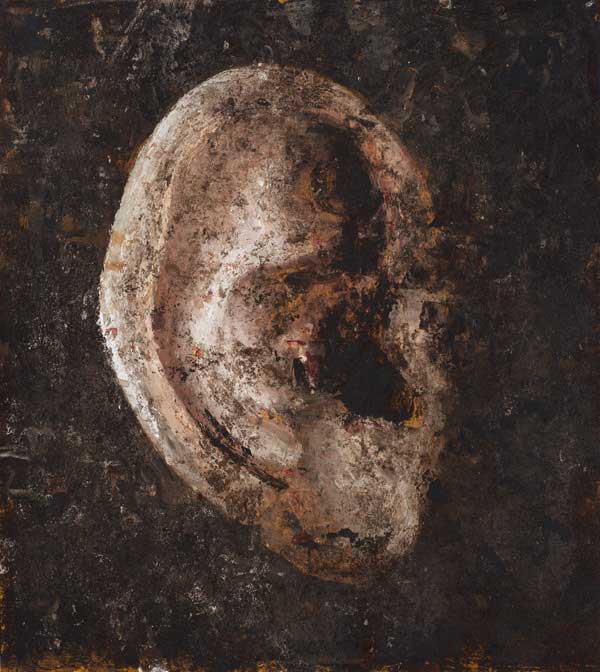
Vincent Desiderio, Study for Ear, 2012 oil and mixed media on board 23 3/8 x 20 7/8 inches
(Courtesy of the artist and the Marlborough Gallery)
Vincent Desiderio will be in residence July 14th to August 4th at the 2014 JSS in Civita Master Class in Civita Castellana, Italy. More information at the JSS in Civita.





excellent. desiderio has such a incisive and powerful way of digressing on painting as a trans-historical form. every thought is quotable, every observation significant and indicative of his years of study and contemplation. great stuff.
Interesting interview. While I appreciate Mr. Desiderio’s effort and interest in making paintings that have more of a cinematic narrative to them, at the end of the day they end up looking a lot like old horror movie posters from the 80s (specifically, the first painting of the eye in the engagement box). The staircase paintings are an interesting perspective, but I wish he painted them more from observation or memory. They remind me a lot of an Instagram picture with a filter put over it. I actually really like the study of the Burning Chair, and wish that the larger version of that painting had more of that energy. I do feel Mr. Desiderio was a bit misleading when he said ‘All of my paintings are inventions. I rarely work with live models so I have been forced to learn to paint from my imagination’. I think it’s plain as day that the driving force behind his work originates from photography. To me, and the painters from the past that Mr. Desiderio claims to have an akin with, imagination has to do with using our mind’s eye, not the camera’s. I look at Carravaggio’s “Martyrdom of Saint Matthew”, and I feel and believe that space(even though it’s fantastical!). It has air. It has weight. It has light. And because of that, it pulls you in to a deep experience that gets you excited about it’s mystery and wonder. Mr. Desiderio’s work does not have that yet, and it wont until he’s more willing to take chances. -H
Han Solo,
Perhaps it’s your childish moniker that’s challenging to people, but I happen to agree with your observations. Mr. Desiderio himself admits that the first image we see in this article is appropriated from a photograph. Maybe not a straight rip-off, but by no means transcendent. His work seems to be (whether or not he cares to admit it) primarily about technical verisimilitude. Which is fine – I love a good illusion. But you’re right when you describe them as cinematic. I’ll go a bit further and say that they’re a bit like stilted dioramas. If I’Liberati doesn’t read like a shallow theatrical stage, complete with a flat backdrop, then one’s depth perception is seriously off. I think he’s technically very gifted, but his images are well this side of transcendent. And, judging by some of his alleged comments below, his thin skin will never allow him to, as you aptly observe, be “willing to take chances.” And to those of you with the juvenile, “what gives you the right to criticize,” “bet you couldn’t do any better” mentality, you’re obviously entitled to your opinions. But go start a fan club and leave the honest valuation of transcendency to others.
“I think it’s plain as day that the driving force behind his work originates from photography.”
Then why are there so many mistakes in anatomy?
Look carefully at the hands in “Hitchock’s hands.” Do they make any sense? Are they realistic? Compare the sizes of the fingertips — these fingers seem to belong to very different hands. Look carefully at the uppermost hand. Can you find the knuckles of the little finger? How does the little finger relate to the ring finger, in terms of the underlying skeletal structure?
The more you look at those hands, the more drawing errors you will see. And don’t get me started on that ear study! All wrong, all wrong.
And yet I think Desiderio is a truly great painter. The extreme drawing errors in these hands are, in a sense, not errors at all, since the mistakes guarantee that you are not seeing a painted photograph.
Han solo,
You must be joking. The air and form in D’s paintings is palpable. He has mastered the art of using photos as reference without projecting the qualities of photographs in his pictures. He creates the illusion of observed light extremely well. “Old horror movie posters from the 80’s?” That’s ridiculous. I agree that some of the pieces here have a cinematic quality, but it is that of anything but the 1980’s. I can see silent movies, or perhaps the 1940’s. You’re way off.
I’d like to chime in on this! Although, I feel a little reluctant to do so because I don’t have the incredible artistic, philosophical, and academic achievements as Desiderio has, but for some reason that’s still not preventing my internal B.S. detector from going off. My attention is on the first image presented, asking what this is, how am I to read into this? I’m looking at the dimensions given, which allows some indication of how to imagine what the painting looks like if viewing it in actuality. The demisons are large, which means the hands holding the box is large, not realistic in scale but over emphasized, taking the motif out of the realm of how one sees and putting into the category of what one sees. The act of seeing is bypassed and is going straight to symbolism or billboard-ism, which maybe is the Desiderio’s point, I don’t know but that is where I personally get bored and go ehh? Also, what’s the deal with the image of “Sleep” is everyone all of a sudden that bored with group sex, has hedonism finally run its course? On a side note, there is a painting by Adolf von Menzel of his hands holding a small square paint dish, which I think puts that big cry baby to bed.
The study of the chair on fire – that has got something to it.
Nah?
As a result, I have difficulty identifying what exactly constitute the fundamentals of drawing and painting. I know that a so called classical education can be beneficial when one wishes to acquire certain types of skill and that programs that offer this type of training are enjoying a renewed popularity among young artists. However I am wary of the rote academic (in the pejorative sense) nature of such an approach. More often than not this pedagogical method tends to imprison student forcing them to force their imaginations into forms that may be inappropriate.
I appreciate Desidero’s statement above, it allowed for me to think out loud my thoughts on academia. It’s funny to me that a certain strand of romanticism (a distain for accriqing applicable knowledge) has grown so large, like a tumor, has now actually become the academic standard in the pejorative sense. As an example, schools are full of romantic academics that complain about perspective drawing, I’ve heard said, “useless, non relevant.” As if these academics can demonstrate how it works, let alone demonstrate its uselessness, especially its development out of the commensurate divion of the square but I digress. The current pedagogical method used today is same as it has always been; it’s a method of indoctrination. Maybe it’s the message that has changed, one from a root in scientific rationalism to a form of Freudian egocentric emotionalism; which one is more marketable if you are selling a commodity? As romantic and liberal as Cézanne was, I seriously doubt that he would recognize and appreciate today’s academia any more than he did of the one during his lifetime. So I pull out my ninth edition, The home book of quotations to the subject of nonsense and Shakespeare apparently said of it, “And such a deal of skimble-skamble stuff.”
RESPONSE TO 2 OF YOU:
YOUR COMMENTS ABOUT MY PAINTINGS UNDERSCORE THAT WHICH I HAVE ALWAYS MAINTAINED, THAT IGNORANCE IS IN THE EYE OF THE BEHOLDER AND I’D THANK YOU NOT TO LOOK AT MY PICTURES .
I think that is a reasonable request and I take back what I said about the image “sleep,” it was clearly over the line and ignorant, sleeping is a time honored tradition. Your mastery of painting should be recognized by all, it’s as if you got it licked, and I hope to be as good as you some day.
Best Wishes,
Jewell
THANKS DAVID. SORRY I GOT MY UNDIES IN A BUNCH. I FEEL A BIT VULNERABLE THESE DAYS.
I rarely respond to interviews or comments, but I feel compelled to do so after reading these. I find it peculiar that Mr. Han Solo, who is so honestly adamant about his skepticism of Mr. Desiderio’s paintings can not being himself to use his real name. weird. ( of course, maybe you are the real Han Solo, in which case I will gladly take that back).
I’d love to see what you can do, Han.
Mr. Desiderio has created some of the most compelling images in contemporary American painting. I think he’s amongst the top 4 or 5 painters in this country.
BM.
bill,
While I’m not smuggling people and merchandise from one system to another, I take pleasure in art and philosophy. The crunch I have with Mr. Desiderio’s work is that it seems to be misrepresented(by him), as I mentioned above. I feel that his work has reach a terminus. I don’t see any exploration or curiosity in his work. The image of the painting has arrived before the actual painting is touched, and not because of the preliminary studies, but because the image of his paintings appears to be transferred from one medium to another. I’m also quite skeptical of how he insinuates that his work embodies the formal concerns and approaches of abstract paintings. His work does not relate to the Modernists and Abstractionists at all. His work relates more with Warhol and Currin, as pertaining to the image, not necessarily the painting. So bill, you are correct, Mr. Desiderio makes images. And if that is all that Mr. Desiderio and others would proclaim, then there is no squabble. -H
“To be is to do.” – Kant
Well, it would be true to say, in and out of academia (and that monolithic thing is hardly one…) that the performer or artisan who excites passionate responses, antipathies and resentments as urgently as acolytes and ingratiators, must truly have something exceptional. Whether these pictures are filmic or post photographic, high Romantic or neo classical, they certainly aren’t lily ponds. Or pretty accidents, or indulgent self expressions making a virtue of the rough and what’s left out because they can’t draw or because they can’t paint any technical thing as well as human forms. These pictures obviously aren’t one thing, and entitled to their experiment and evolution. It seems to me they are in some way genuinely personally haunted and yet very learnedly manipulative, which is as it should be, perhaps, with works of art. (The tradition of Thomas Eakins can stand proud, not least in the fascination with optics, thematically, and in operation.).
But John Currin…? Good grief.
P.S Also, what’s wrong with the transference of a well-wrought urn from one medium to another?
‘what’s wrong with the transference of a well-wrought urn from one medium to another’ – Kind of like transferring an image on to a t-shirt? Answer: it ends up being solely about the image. Which is fine if you align yourself with the Warhol camp. But in this case, Mr. Desiderio is a bit misleading in saying that he is “inventing” all the images in his paintings. Artists need to strive for honesty at every pass.
Yes, John Currin.
What’s wrong with lily ponds? Or pretty accidents? We have become too dismissive of what seems weak, or ordinary. Beauty exists in the seemingly mundane. But not because of the imagery, but because beauty is everywhere people are willing to look. Give me honesty over manipulation any day of the week.
There is nothing wrong with paintings that are more ‘filmic’. El Greco, Caravaggio, Rembrandt, Velasquez, Ensor, Dickinson, and more recently Susanna Coffey have all created paintings that could be considered “filmic” in some way or another. And when I say filmic, I mean how film “moves”. The artists’ paintings listed above move. They vibrate. They have air. They are infinitely more dreamy. Their work does not appear to be a snapshot with flat space. That is the difference.
Great work, interesting interview!
I find the suggestion that he’s just ‘transferring’ reference images to the canvas, strange…. There is a reason most middling painters don’t get past the still life and single figure pieces. It takes so much invention, based in knowledge of form and lighting. Desiderio has been doing this a long time, of course he can freestyle a painting!
Anyway, let’s get real…there are few people pushing art in any direction, least of all from the ones that think that they are pushing art. For me, I actually love the frozen quality in his work, it makes me feel more like a voyeur, which in turn makes me consider my own relationship to the piece as viewer, and adds to the perplexity of the narrative.
I actuallly do agree that some of the works seem to lack ‘air’ – but that’s a good thing! It’s like they’ve been vaccuum sealed, and preserved in the most delightfully 20-21st century manner.
Not entirely sure what the criticisms are about.
Keep up the great work Vincent!
What makes you believe that the imagery in Mr. Desiderio’s work is coming from anywhere except from magazines, photos, or stilled scenes from TV screens? What qualities are you seeing in his work that make you feel that he is inventing the same way Caravaggio or El Greco have? I don’t understand how anyone could look at his paintings and assume they are “freestyled”.
Do you really believe Mr. Desiderio is closing his eyes and imaging the scene in “I’Liberati”? Or any of his paintings for that matter?
I don’t see how a lack of “air” (space) is something to be desired when looking at paintings.
When it comes to personal preference, to each his own. But like I’ve been stating, there is an honesty that artists must struggle for in their work and how they present it. That above all else should be the first concern.
“An honest man is always a child.” – Socrates
DEAR HAN SOLO
WHEN ONE READS COMMENTS SUCH AS YOUR FRANKLY DISMISSIVE ONES CONCERNING MY WORK, ONES FIRST REACTION IS TO PRESUME THAT THEY ARE COMING FROM A TREMENDOUS SOURCE OF INSIGHT AND EXPERIENCE.
AS PAINTERS ARE OFTEN THEIR OWN GREATEST CRITICS, THEY ARE INCLINED TO FIND IN, NEGATIVE RESPONCES, A BITTER TRUTH THAT IS, AT ALL TIMES, PRESENT IN THE MIND OF THE ARTIST.
HOWEVER IN YOUR CASE I DETECT A STUNNING IGNORENCE OF PAINTING AND IT’S PRACTICE. MOREOVER, I SENSE THAT YOU SPEAK FROM THE POSITION OF ANGER AND RESENMENT OFTEN FOUND IN THOSE OF LITTLE ACCOMPLISHMENT AND PERSONAL FAILURE. YOUR PLACE IS, LIKE SO MANY OF YOUR KIND, CONFINED TO THE SIDELINES- A PLACE FROM WHICH YOU CAN SMUGLY PERFORM YOUR RANTS AND RAVES WHILE GIVING YOURSELF CREDIT FOR AN AUTHENTIC UNDERSTANDING OF WHAT TRUE PAINTERS DO…THINGS THAT ARE, MORE THAN LIKLY, BEYOND YOUR TALENTS, INTELLIGENCE AND IMAGINATION. TAKE A TIP FROM YOUR PAL, CHEW-BACCA…KEEP WHINING.
Or…I once saw Dylan on stage at the low point of his creative career, the mid 80’s..he said this, slightly paraphrased…
Just once I’d love to see these critics that always rip me stand up here on stage and sing a song that they wrote.
Did Bob Dylan ever claim to be a rapper instead of a singer song writer? Because of he did, I would find criticism appropriate.
Dear Mr. Desiderio,
I am responding to your words that are written above. I am also responding to the thoughts left behind on this thread. Considering that, how have I been dismissive of what you’ve said in conjunction to your work?
You are correct, I am not very successful in life, and I do consider myself to be more of a spectator. But that should not discourage anyone from demanding truth. It is my belief that Art has the chance to be a sacred experience. There is no room for adulteration. My angle is not coming from anger or resentment, but more of a yearning for honesty and truth.
I would welcome you to point out how I have been dismissive or how my criticisms of what you’ve said are missing the mark.
-H
This is interesting to see unfold truly, the argument is gett’n warm. I thought I was done; perhaps I am really but would like to interrupt a little. I know, I know, some of you are saying stay out of it “Snuggler” but I can’t help it, that’s just my nature.
First off, let’s keep good’Ol Dylan out of this, he said a lot of things over the years plenty of which while under the influence (me too), sometimes mysterious and enigmatic things that are light years away from any of us because of our credulous natures. I always liked the one, “you can’t be in love and wise at the same time,” great stuff. Let’s just use what are at hand, the article, and the images.
Secondly, the mention of success or lack thereof is juvenile at best, that stuff is relative, or maybe it’s not? Maybe, everyone one should take into consideration all of the financial investment being put into Desiderio’s work. Why, what is the agenda? For me, I’m wondering, since Desiderio brought it up as a poor ad hominem towards Han, could he do any of this if he lived on the margins or side lines of society, would he being doing any of this if no one was looking? For me (a prelude to my third point), the way of figuring if a painting is successful or not is to put it up against one that has had some time to cook. I know of a small early Matisse that gets no attention, that if put next to Desiderio’s “Hitchcock’s Hands” would make it look like bad graduate work. You know, that mistake we all make when first learning to juggle relative scale. Some folks atone of this huge goof, others try to give it “cultural context,” aghh, gag. Let me say that more clearly, so that The Marlborough can hear, Ahh, Gag.
Thirdly, on to what is truth in painting, good luck folks? I know that I said bringing Dylan into the argument was a bad idea, and that it will seem contradictory of me introducing a fancy quote, but others before us have said it better. I’ll use one from a dead white guy, Mark Twain, “Truth is stranger than fiction, but it is because Fiction is obliged to stick to possibilities; Truth isn’t.” So, I suppose you could say that’s why people like fiction, because it makes sense.
And fourthly, what is the deal with using all CAPS; relax, it’s just a discussion, snuggle it out.
See: http://youtu.be/3DsUTW4MdtM
DEAR HAN.
LET ME BEGIN BY SAYING THAT I AM THE LAST PERSON QUALIFIED TO JUDGE ANOTHER’S SUCCESS OR FAILURE, FEELING AS I OFTEN DO, THAT I HAVE ONLY SCRATCHED THE SURFACE OF WHAT I HOPE TO UNDERSTAND AND THAT I SUFFER FROM CRIPPLING SELF DOUBT. THESE FEELINGS ARE, NO DOUBT, THE ORIGIN OF MY DEFENSIVENESS.
OF COURSE YOU ARE IN THE RIGHT TO EXPRESS YOUR OPINIONS (WHICH ODDLY ENOUGH REFLECT SOME OF MY OWN – ESPECIALLY REGARDING PRIVILEGE ACCORDED THE SIGN (IMAGE OR DRAMATIC NARRATIVE) OVER THE SEARCHING COMPLEXITIES OF METHOD OR WHAT I CALL THE TECHNICAL NARRATIVE.
BUT TO SAY THAT THE DRIVING FORCE OF MY WORK IS THE PHOTOGRAPH IS ABSURD AND WOULD BE TO ANYONE WHO HAS SEEN THE PAINTINGS IN PERSON. SOURCE MATERIAL OF ALL KINDS GOES INTO THE PAINTING OF THESE PICTURES. TAKE, FOR EXAMPLE, ‘I LIBERATI.’ DO YOU REALLY BELIEVE THAT I GATHERED A GROUP OF MODELS ( SOME OF THEM SEVERELY RETARDED) OUTSIDE AT NIGHT. ILLUMINATED BY A HEADLIGHT IN FRONT OF A WALL WITH THE LIGHTS VISIBLE ON THE FAR SIDE OF A RIVER IN THE BACKGROUND? THAT I THEN PHOTOGRAPHED THEM AND MERELY TRANSFERRED THE PHOTO IMAGE TO CANVAS? IF YOU HAVE EVER ATTEMPTED TO CONSTRUCT A PICTURE IN SUCH A WAY YOU WOULD REALIZE QUICKLY THAT THE PHOTOGRAPHIC INFORMATION IS WOEFULLY INADEQUATE…OFFERING NOTHING IN TERMS OF VOLUME, TEMPERATURE OR THE COMPLEXITIES OF THE OPTICS OF ILLUMINATION.
TWO OF THE FIGURES ARE AMALGAMS OF PHOTOGRAPHIC INFORMATION AS WELL AS OBSERVATION, LIFE STUDIES AND INVENTION. THE CENTRAL FIGURES WRESTLING, ARE PAINTED COMPLETELY OUT OF MY HEAD AS ARE THE OTHERS. BUT THE OVERALL CONCEPT (ITS SPACE,THE NIGHT, ITS ILLUMINATION, ITS COLOR , THE TECHNICAL DEVELOPMENT, ETC. ARE ALL FROM MY IMAGINATION. THUS I WOULD SAY THAT A GOOD 90% OF THE PAINTING WAS CONSTRUCTED BY MY “MIND’S EYE” FROM MEMORY, AS IT WERE.
THERE ARE ABOUT 5 VERSIONS OF THE COMPOSITION UNDERNEATH THE FINAL SKINS OF THIS PAINTING…FIGURES FULLY REALIZED THAT I PAINTED OUT TO MAKE ROOM FOR OTHER FIGURES. I WORKED AND REWORKED THE PICTURE OVER MONTHS UNTIL IT RESEMBLED THE IMAGE THAT I HAD IN MY MIND!!!
TO SPEAK OF A SIMPLE TRANSFERENCE OF AN IMAGE FROM ONE MEDIUM TO ANOTHER LIKE “TRANSFERRING AN IMAGE ON TO A TEE SHIRT” IS, INDEED, DISMISSIVE OF WHAT I HAVE ATTEMPTED IN MY WORK.
NONETHELESS, I WELCOME ANY SOURCE MATERIAL AS EQUIPMENT FOR MY PAINTINGS. ‘HITCHCOCKS HANDS’ IS INDEED A PAINTING OF A STILL FROM AN OPENING SEQUENCE OF THE TV SHOW “ALFRED HITCHCOCK PRESENTS.” I SIMLY WANTED TO APPROPRIATE IT. IT IS UNIQUE AMONG MY PAINTINGS AS A DIRECT REFERENCE.
BUT TO ASK AS YOU DO “What makes you believe that the imagery in Mr. Desiderio’s work is coming from anywhere except from magazines, photos, or stilled scenes from TV screens?” IS UTTERLY DISMISSIVE.
A FEW YEARS BACK, A WOMAN WAS STANDING IN FRONT OF MY PAINTING ‘COCKAIGNE,’ A PAINTING OF 500 ART BOOKS
SCATTERED ON THE FLOOR AROUND A HALF EATTEN MEAL. SHE ASKED ME WHERE I WAS STANDING WHEN I PAINTED IT. WAS I ON A LADDER? WAS MY STUDIO FILLED WITH BOOKS SO THAT IT COULD PHOTOGRAPH THEM FROM ABOVE FROM ABOVE?
MY RESPONSE WAS THAT I WAS STANDING JUST WHERE MICHELANGELO WAS STANDING WHEN HE PAINTED THE CREATION OF MAN. THAT IS TO SAY, THE PAINTING WAS PURE INVENTION.
“MY RESPONSE WAS THAT I WAS STANDING JUST WHERE MICHELANGELO WAS STANDING WHEN HE PAINTED THE CREATION OF MAN. THAT IS TO SAY, THE PAINTING WAS PURE INVENTION.”
That is so cute, but you are also suggesting that you were standing on the ceiling, standing over here, standing over there, standing everywhere, perspective is everything, so are proportions; was she impressed by your statement because I’m not. Also, don’t get angry at me because I don’t care for “Hitchcock Hands”.
Oh, come on Mr. Jewell! The perspective in Cockanigne is awesome, and its construction required skill, imagination, knowledge and invention.
4. i am too lazy to use correct capitalization when needed.
3. i agree with TWAIN
2. why don’t you check my dismal sales record at marlborough
and by the way, kiss my ass regarding my stuff looking like graduate work…clearly you’re no MATISSE.
1. artists sometimes speak enigmatically. but what DYLAN said about critics is clear as day.
and that includes you too david parker jewell
Are serious, I’m disappointed in your ability to argue; you really teach at PAFA? Ok, I’ll leave you alone since you seem so tender, I don’t want our exchange to appear negative, healthy, but not negative.
Hey, Han Troll ‘O — The Bridge just called. He wants you back under him.
Mr. David Jewell Parker said: I know of a small early Matisse that gets no attention, that if put next to Desiderio’s “Hitchcock’s Hands” would make it look like bad graduate work.
Matisse making Desiderio look like graduate work ?- uh, yeah, sure, i agree – if we were living in Superman’s Bizarro world, just maybe. Where everything is upside down.
Aurelia – if this was facebook, a very big laugh & a like.
@ Bill Murphy ^_^
i’m flabbergasted by what is going on here. i have shown the work of both desiderio and david jewell (if the poster above is the painter david jewell) to my painting students for years. i have known a number of other painters in the perceptualist camp (emil robinson, matt klos, sangram majumdar, eve mansdorf,et al), and i can’t imagine any of them being ornery with desiderio’s work. the man is not pulling the wool over our eyes. he’s not doing one thing and calling it another (like a great many artists we could think of).
it’s frustrating to think that anyone of the perceptual painting mindset – who trace some lineage of image making via fairfield porter and edwin dickinson through to lennart anderson and others – wouldn’t have a place for the appreciation of the sort of work that desiderio does. his contribution is amazing and his command of the history of images is really second to none. similarly, given the company that david jewell appears to keep as well as the works of his that i’ve seen (admittedly only online), he appears to be a fantastic, committed, intentional painter. why there can’t be a mutual understanding of the common ground upon which we stand here is strange to me.
i interpreted the naming of desiderio as the 2014 JSS in civita master class guest-of–honor as indicative of the idea that perceptual painters appreciated and saw great value in the experience and background in painting and art making that he has. i still believe that. while it makes total sense that some people might not be warm to his paintings or approach, it also holds that we’d extend some common courtesy and generosity of spirit to others who seek out many of the same things we do.
maybe it could be said that of the above comes down to “why can’t we all just get along?” but i think there’s more than that.
It’s ok, I’ve got my own thoughts, and we don’t all agree, which is healthy; it’s a way of testing them to see if they float. And yes, I’m very ornery, it’s my nature.
Han,
The term ‘air’ as it pertains to painting is vague, and your assessment of it – like mine – completely personal. I do not think you understand how a representational painting is made, and while I truly don’t think that being able to actually ‘do’ is a prerequisite for critique, you might consider that the act or process of art making can have a strong impact on both the viewer’s reaction to, and analysis of a work. To this end, no, I do not think that any video still or photo can operate in the same manner as mr. Desiderio’s art, even if one did exist.
Dear Mr. Desiderio,
Of course I don’t believe you staged all of those people in ‘I LIBERATI’ and photographed it. But I’m more willing to believe that most of your work, including that one, involves collaging sourced material rather than you using your ‘mind’s eye’ as you claim. There is a difference between inventing from our imagination vs inventing from a preexisting image.
You stated above, ‘All of my paintings are inventions. I rarely work with live models so I have been forced to learn to paint from my imagination.’ I believe you were misleading(consciously or unconsciously) in that statement. Your statement would be more fitting coming from someone like Goya, for instance. That is my contention. That you’ve aligned yourself with a group of painters that you don’t have that much in common with, other than superficial concepts about realism and figuration. There is a huge difference between someone like John Currin and someone like Caravaggio. The neophytes might not be able to recognize it, but most art scholars do.
I understand that Antonio Gramsci has passed away long ago, and so any attempt in painting an image of Gramsci would require an image of him from a sourced material. That said, a quick google image search of Antonio Gramsci brings us to a black and white photograph of him from a Wikipedia page that can easily be attributed to your painting of ‘Exodus’. It is the manner of how you copied that image(to the very detail) that lends me to believe that you are not being as forthcoming about your process as you let on. Not that you used that picture, but instead, how.
http://en.wikipedia.org/wiki/Passive_revolution
But I understand that might be more of an anomaly considering how important his presence was to you in ‘Exodus’. But after googling “statues having sex”, I discovered the direct inspiration for ‘Transubstantiation’. Granted, there seems to be a tiny bit more editing in this one from the original image, but this painting is in fact inspired from anything other than your imagination.
http://pixersize.com/wallmurals/temples-of-khajuraho-famous-for-their-erotic-sculptures-40573727
Both of those images were fairly easy to find, and I’m not going to bother trying to find more from your other paintings. But by seeing how accurate the images on your paintings are to those photographs, I’m led to believe that your above statement is most definitely misleading and that I wasn’t being dismissive at all.
You and others may feel that I am picking on you, but I am simply making a request for artists to be as truthful as possible when representing themselves and their craft. The deepest part of my argument is not that you use photography or sourced material, but that your posturing in the interview was crooked.
I get it now!!! You guys are all perceptual painters – no wonder the emphatic distaste for source material beyond the eyes and Edwin Dickinson. OMG! My bad! LOL. WTF.
good bye, dear friends. It has been fun!!
From what I have been told about Dickinson, by those who knew him, he would be the last person to foster an orthodoxy of any kind, particularly one that imposed some sort of restrictions on sources of creativity. For me, photography is just another way to excavate the image I’m digging out.
The problem must lie on the use of the term imagination. Certainly not all of the images in my large body of work over 40 years of painting are directly dirived from pre existing images. You must know that if you know my work. This last show of mine had to do with the hardening of thought and not always on ways that are beneficial. As such it was perfectly appropriate that I used statuary as models for some of the images. I know that you think that I misrepresented myself when I spoke of painting from my imagination. I really meant that the most important part of painting is the invention of the technical narrative as opposed to the dramatic narrative. This I developed from my imagination imbuing the images with a different vitality than they might appear elsewhere. It is a process of self exploration and technical exploration. This process of self education never ends. No matter how many years we have been painting. There is no ruse. I make no claims to never use sources outside of my oun Invention.
I liberati however was in fact painted overs my months from my imagination. There was no pre existing image except that which was in my mind. Believe it or don’t. It’s of no great matter to anything.
You guys are certainly a strange bunch. Words like sacred and truth … As if only a few are privy to their elusive meanings. These are terms that carry a great weight and are not to be bandied abou lightly. Many have given their lives defending their personal investments in these concepts.
Why do you think that Degas said that the painting should be executed like the perfect crime? Or that Picasso said that it was a lie through which the truth is revealed? Or that Michelangelo wondered why one would ever paint what he saw?
I can accept your criticism that, “we are a strange bunch.” You mean those who are searching and questioning right? I’ve had to carry that projected sentiment my entire life and have come to accepted it as normalcy and I bet you have too; would you like back into the bunch? And is it really that strange to question and not accept what is being presented? Or is it even stranger to voice dissent in artwork that purports to be preeminent? I’ve never liked bedtime stories.
Dear Mr. Jewell,
On the basis of your bitter, tea party style rant, I would hastily reject the invitation to join you in your myopic and basically fundamentalist “search” for mediocrity.
But keep painting. You may one day see the light.
-V
Ok, again, more smallish ad hominem; so am I to understand you, that according to your response, I’m not as “liberal” as you? Am I at the schoolyard monkey bars again and no one has had the decency to remind me, assumptions much? At this point, you keep giving me more reasons not to take you so seriously (big paintings and all); it may be you in fact that prefers the controlled, polished narratives, a special kind of slick mediocrity, which has more in common with the “fundamentalism” you are so poorly attempting to blame me for, are you trying to come clean? What “light” are you referring to anyways, yours? -Jewell
I usually don’t get involved with comments other than to keep a eye out for spam and/or something abusive or totally inappropriate. I’ve been keeping a close watch on the comments for Vincent Desiderio’s interview as some of the comments are on the edge of what I feel comfortable with. I have enormous respect for Vincent’s work and stature and it pains me to see this disrespect.
Sadly, I suppose being famous comes with a price that people are more likely to vent and rant their cause and belief system as it may get more public attention than otherwise. However, any disrespect on any artist, no matter how famous, on this blog is upsetting and I apologize to Vincent for not asking before hand if he’d like comment disabled. However the generally reasoned and civil tone of the arguments (even if I do disagree) have stopped me from doing anything other than observe so far. I thought this argument had run its course but it seems some embers are still burning. I’d also like to add that I don’t like the idea of people posting anonymously. If you have something to say you should own up to it and not hide behind a false ID.
I’ve always appreciated good honest arguments and that is why I’ve maintained my real name with my comments. I have not, and would not hide behind a false ID. I apologize for anything that may have been perceived as inappropriate or disrespectful. I will no longer continue to post any comments on this website. Thank you. -Jewell
Mr. Jewell – Can you name one objective VISUAL argument you have made in all these posts? And would you be willing to post images of a few of your paintings in order to illustrate?
Very interesting discussion indeed, for many reasons. I would like to offer you a perspective, not taking any side in this particular debate. I am a painter and printmaker working in Norway, Europe (please excuse my english). Even though I live in Norways second biggest city, I am one of maybe two or three figurative painters here. There are literally no scene for traditionally founded painting or drawing in this country, except for the Nerdrum school, who mostly keep to themself. There is no education options for figurative work whatsoever. Very few people, be it in the educational system, in galleries or institutions, know anything about figuration. No artist would be able to discern a painting made from photographic material from one made on observation. There is no public debate concerning painting in any form. Conceptual and experimental art is prevalent, abstract art is still interesting. Maybe it is a good thing to disagree and fight over whitch figurative approach is better, but know that it is a luxury.
Tom,
I’m sorry to hear that you have so few choices in your country. While I agree that it is a luxury to debate about such topics, it’s worth fighting for. And yes, abstract art is a good thing. The Modernists were all about the experience and would have rejected this new era of “photo-collaged illustration” that some call painting. Glad to see that you are open to discussion over in Norway!
Wow. I’ve been coming to this blog for a few years now and I don’t think I’ve ever seen such vitriol thrown at a featured painter. It’s disturbing and from my perspective what I’ve read here is not “ good honest arguments” in the least.
There is a quote that has been attributed to Mark Twain and Abe Lincoln, I’m not sure which man said it but it seems to be good advice for all at one time or another.
“It is better to keep your mouth closed and let people think you are a fool than to open it and remove all doubt.”
I just discovered Vincent Desiderio yesterday but sheer accident. I was on Facebook and daydreamed of going to Florence, Italy again when I saw an ad for a summer master class offered by JSS in Civita, Italy. wanting to know more about the summer course, I went to Their website and watched a video of an interview of Mr Desiderio and his work currently being shown at the Marlborough Gallery. I haven’t seen any work that I have been excited about in quite awhile. IMHO Desiderio is one of the greatest painters living if not dead, and It is quite obvious to little ol’ me (I am a painter with an MFA), that Mr Desiderio does have a huge intellect and a very expansive imagination capable of constructing complex compositions from his ‘mind’s eye’. Why anyone would question his statements is extremely bizarre and unfounded! Pettiness and jealously are destructive forces that will come back to haunt Mr Jewel.
Ditto Ms. Kerly.
Vincent, go back to your easel and never return to this cyberswamp, it is far beneath you. Your work is tremendous. A child could see that at a glance. All this ‘look how clever I am’ wordplay is for those with no talents to cultivate or not sense enough to identify and cultivate them. This message is meant for Vincent and no other. So no clever ripostes, please.
Critical discourse about art and artists, involving artists and any others, is painting’s life blood, surely?
Terrific painters aren’t very often mute and sometimes they are the greatest and most passionate critics. Desiderio is hardly at a loss for words and his defenses, whether reflective or off the cuff and fed up, are insightful for students and other painters, psychologists and critics. He couldn’t have disported himself better, probably, if he’d been able to write all of the responses for himself.
Of course some of this exchange has been disconcertingly and unexpectedly on the side of ‘spleen’, but the history of great painting, like great poetry, is hardly above the gutter. Caravaggio didn’t come out of The Ruskin School of Drawing and probably wouldn’t have hung about for too long in Kettle Yard.
I’m sure this exchange woke up more than a few people as they drifted through the usual cliche abeyances of key artist interviews on this (otherwise) excellent website. It certainly made me forget to chew my dinner and miss two television shows.
And the most scathing commentaries on Desiderio’s work here simply made me want go back to look at particular paintings again and want to see his work in the real, having posed further considerations. Jealousy is surely as natural to painting as it is to love, and when it’s naked it’s probably far more noble than the group cultivations that systematically endorse the mediocre as a way of excluding the disturbances of the apparently too easy, obvious, natural or odd and serendipitous talent. By reducing it to its methodologies, as if that made it less or something anyone could attain, before their fact. It seems to me that great art always seems obvious after its fact, and spawns then the myriad but never quite there of its emulators.
The exchanges here, for all of their lack of civility, brought new appreciation therefore and certainly no less pleasure in the work or respect for Desiderio’s immense labour and talent, whatever its sources, influences, props, transferences and techne. My looking simply became far less idle.
Isn’t that what a painter wants?
Well said Robyn – interesting discourse overall.
Vincent has made himself clear; to paraphrase: “…[the] PRIVILEGE ACCORDED THE SIGN (IMAGE OR DRAMATIC NARRATIVE) OVER THE SEARCHING COMPLEXITIES OF METHOD OR WHAT I CALL THE TECHNICAL NARRATIVE [is a valid point]. BUT TO SAY THAT THE DRIVING FORCE OF MY WORK IS THE PHOTOGRAPH IS ABSURD… SOURCE MATERIAL OF ALL KINDS GOES INTO THE PAINTING OF THESE PICTURES [but] PHOTOGRAPHIC INFORMATION [offers] NOTHING IN TERMS OF VOLUME, TEMPERATURE OR THE COMPLEXITIES OF THE OPTICS OF ILLUMINATION… THE OVERALL CONCEPT (ITS SPACE,THE NIGHT, ITS ILLUMINATION, ITS COLOR , THE TECHNICAL DEVELOPMENT, ETC. ARE ALL FROM MY IMAGINATION. THUS I WOULD SAY THAT A GOOD 90% OF THE PAINTING WAS CONSTRUCTED BY MY “MIND’S EYE” FROM MEMORY, AS IT WERE.” That the portrait of Gramsci referenced a photo is self-evident, given that Gramsci died in 1937…
Vincent wrote a brilliant essay on this subject entitled “Toward an Allegorization of Method” for a Skira/Rizzoli book I edited, “The Figure,” out this October. Other contributors include Alexi Worth, who writes about the impact of photography on 19th c. painting. Along with strictly perceptual painters like Scott Noel, various artists, such as Edgar Jerins, Jerry Kearns, and Nicola Verlato, wrote ‘artist methodologies’ in which their use of photography, Photoshop and CGI in the creation of figurative artwork is explained.
The idea of not using all tools available in the creation of a work of art and expecting other artists to follow this restriction – or religion – is idiotic.
The artists who box themselves in may find comfort in all their rules and convictions and their self righteousness but please – take a hard look at your own work.
Did I mention backgrounds?
Edgar Jerins
DESIDERIO,
YOUR WORKS ARE JUST EXTRAORDINAIRE…..IT DOES NOT REQUIRE ANY EXPLANATION. LET THE IMAGE SPEAKS OF ITS SELF.
CONGRTULATION TO YOU AND TO THE WORLD OF ART THAT PEOPLE/ARTIST LIKE YOU STILL EXIST.
“TU TRABAJO ES ASOMBROSO” IT COMUNICATES…SO MANY THINGS, ITS A WORLD IN IT.
UN ABRAZO
GUILLERMO SEPULVEDA
MONTERREY MEXICO.
I’m encouraged to work even harder on my painting skills,observation and such…thanks to comments like ‘Han Solo’s’.It’s nice to know that there are people who can see the difference.
Michal,
I’m glad you are encouraged. I think sometimes it’s hard for artists (painters especially) to realize what is at stake. The end goal is not just about the image, it’s about the experience, and making that experience unadulterated. The cyber world (Instagram) is making painting more and more into a “quick fix” experience. Real painters like Morandi might become extinct unless we hold a mirror up to society. Lets slow down and look.
Wow.
http://www.johndalton.me/podcast/ep-77-vincent-desiderio/
Interesting recent podcast interview with Desiderio.
Happy New 2017!